Bonnie and Clyde
| Bonnie Parker and Clyde Barrow | |
|---|---|
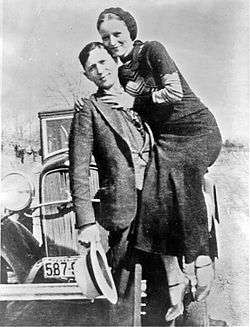 Bonnie and Clyde in March 1933 in a photo found by police at the Joplin, Missouri hideout |
Bonnie Elizabeth Parker (October 1, 1910 – May 23, 1934) and Clyde Chestnut Barrow a.k.a. Clyde Champion Barrow[1] (March 24, 1909 – May 23, 1934) were American criminals who traveled the central United States with their gang during the Great Depression, robbing people and killing when cornered or confronted. At times, the gang included his older brother Buck Barrow and his wife Blanche, Raymond Hamilton, W. D. Jones, Joe Palmer, Ralph Fults, and Henry Methvin. Their exploits captured the attention of the American public during the "Public Enemy Era," between 1931 and 1935. Though known today for their dozen-or-so bank robberies, the two preferred to rob small stores or rural gas stations. The gang is believed to have killed at least nine police officers and several civilians. The couple were eventually ambushed and killed by law officers near the town of Sailes, in Bienville Parish, Louisiana. Their reputation was revived and cemented in American pop folklore by Arthur Penn's 1967 film Bonnie and Clyde,[2] in which they were played by Faye Dunaway and Warren Beatty.
Even during their lifetimes, their depiction in the press was at considerable odds with the hardscrabble reality of their life on the road, especially for Bonnie Parker. She was present at a hundred or more felonies during the two years she was Barrow's companion,[3] but she was not a machine gun-wielding killer as depicted in the newspapers, newsreels, and pulp detective magazines of that time. Gang member W. D. Jones later testified he could not recall ever having seen her shoot at a law officer.[4][5] Bonnie's reputation as a cigar-smoking gun moll grew out of a playful snapshot police found at an abandoned hideout. It was released to the press and published nationwide. While Parker did chain smoke Camel cigarettes, she never smoked cigars.[6]
Historian Jeff Guinn writes that the hideout photos led to Parker's glamorization and the creation of legends about the gang:
John Dillinger had matinee-idol good looks and Pretty Boy Floyd had the best possible nickname, but the Joplin photos introduced new criminal superstars with the most titillating trademark of all—illicit sex. Clyde Barrow and Bonnie Parker were wild and young, and undoubtedly slept together.[7]
Bonnie Parker
| Bonnie Parker | |
|---|---|
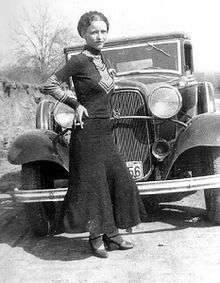 Parker with 1932 Ford V-8 B-400 convertible coupe. | |
| Born |
Bonnie Elizabeth Parker October 1, 1910 Rowena, Texas |
| Died |
May 23, 1934 (aged 23) Bienville Parish, Louisiana 32°26′28″N 93°05′34″W / 32.441217°N 93.092659°W |
| Cause of death | Gunshot wound by law enforcement |
| Resting place |
Crown Hill Memorial Park Dallas, Texas |
| Nationality | American |
| Spouse(s) | Roy Thornton (1926-34; her death) |
Bonnie Elizabeth Parker (October 1, 1910 – May 23, 1934) was born in Rowena, Texas, the second of three children. Her father, Charles Robert Parker (December 29, 1884 - December 31, 1914), was a bricklayer who died when Bonnie was four.[8] Her mother, Emma (Krause) Parker (September 15, 1885 - September 21, 1944) moved her family to her parents' home in Cement City, an industrial suburb now known as West Dallas. She worked as a seamstress.[9] Her maternal grandfather, Frank Krause, came from Germany.[10] As an adult, her fondness for writing found expression in poems such as "The Story of Suicide Sal"[11] and "The Trail's End" (known since as "The Story of Bonnie and Clyde"[12]).
In her second year in high school, Parker met Roy Thornton. They dropped out of school and were married on September 25, 1926, six days before her 16th birthday.[13] Their marriage, marked by his frequent absences and brushes with the law, was short-lived. After January 1929, their paths never crossed again. However, they never divorced, and Bonnie was wearing Thornton's wedding ring when she died.[14] Thornton was still in prison when he heard of her death. He commented, "I'm glad they went out like they did. It's much better than being caught."[15]
In 1929, after the breakdown of her marriage, Parker lived with her mother and worked as a waitress in Dallas. One of her regular customers in the café was postal worker Ted Hinton, who would join the Dallas Sheriff's Department in 1932. As a posse member in 1934, he participated in her ambush.[16] In the diary she kept briefly early in 1929, Parker wrote of her loneliness, her impatience with life in provincial Dallas, and her love of talking pictures.[17]
Clyde Barrow
| Clyde Barrow | |
|---|---|
 Clyde Barrow in 1926, aged 17 | |
| Born |
Clyde Chestnut Barrow March 24, 1909 Ellis County, Texas |
| Died |
May 23, 1934 (aged 25) Bienville Parish, Louisiana 32°26′28″N 93°05′34″W / 32.441217°N 93.092659°W |
| Cause of death | Gunshots by law enforcement |
| Resting place |
Western Heights Cemetery Dallas, Texas |
| Nationality | American |
| Height | 5 ft 6 in (1.68 m)[18] |
Clyde Chestnut Barrow[19] (March 24, 1909 – May 23, 1934) was born into a poor farming family in Ellis County, Texas, near Telico, a town just southeast of Dallas.[20][21] He was the fifth of seven children of Henry Basil Barrow (January 10, 1874 in Alabama – June 19, 1957 in Texas) and Cumie Talitha Walker (November 21, 1874 – August 14, 1942). Clyde's siblings were Elvin Wilson Barrow (June 20, 1894 - 1947), Artie Adell Barrow (March 30, 1899 - March 3, 1981), Marvin Ivan Barrow (March 14, 1903 - July 29, 1933) (nicknamed Buck), Nellie May Barrow (May 12, 1905 - 1968), L.C. Barrow (August 13, 1913 - September 9, 1979) and Lillian Marie Barrow (May 27, 1918 in Kerens, Texas - February 3, 1999).
The family migrated, piecemeal, to Dallas in the early 1920s as part of a wave of resettlement from the impoverished nearby farms to the urban slum known as West Dallas. The Barrows spent their first months in West Dallas living under their wagon. When father Henry had put together enough money to buy a tent, it was a significant improvement for the family.[22]
Clyde was first arrested in late 1926, after running when police confronted him over a rental car he had failed to return on time. His second arrest, with brother Buck, came soon after, this time for possession of stolen goods (turkeys). Despite having legitimate jobs during the period 1927 through 1929, he also cracked safes, robbed stores, and stole cars. After sequential arrests in 1928 and 1929, he was sent to Eastham Prison Farm in April 1930. While in prison, Barrow used a lead pipe to crush the skull of another inmate, Ed Crowder,[18] who had repeatedly sexually assaulted him.[23] This was Clyde Barrow's first killing. Another inmate serving a life sentence took the blame, however.[18] Barrow convinced another inmate to use an axe to chop off two of Barrow's toes in order to excuse him from working hard labor in the fields; Barrow would walk with a limp for the rest of his life as a result.[18] Unbeknownst to Barrow, his mother successfully petitioned a release for him, six days after his intentional injury.[18]
Paroled in February 2, 1932, Barrow emerged from Eastham a hardened and bitter criminal. His sister Marie said, "Something awful sure must have happened to him in prison, because he wasn't the same person when he got out."[24] A fellow inmate, Ralph Fults, said he watched him "change from a schoolboy to a rattlesnake."[25]
In his post-Eastham career, Barrow chose smaller jobs, robbing grocery stores and gas stations, at a rate far outpacing the ten to fifteen bank robberies attributed to him and the Barrow Gang. His favored weapon was the M1918 Browning Automatic Rifle (called a BAR).[18] According to John Neal Phillips, Barrow's goal in life was not to gain fame or fortune from robbing banks, but to seek revenge against the Texas prison system for the abuses he suffered while serving time.[26]
First meeting
Several accounts describe Bonnie and Clyde's first meeting, but the most credible tells that Bonnie Parker met Clyde Barrow on January 5, 1930 at the home of Clyde's friend Clarence Clay at 105 Herbert Street in the Oak Cliff neighborhood of West Dallas. Parker was out of work and was staying with a female friend to assist her with her broken arm. Barrow dropped by the girl's house while Parker was in the kitchen making hot chocolate.[27]
When they met, both were smitten immediately; most historians believe Parker joined Barrow because she was in love. She remained a loyal companion to him as they carried out their crime spree and awaited the violent deaths they viewed as inevitable.[28]
The Spree
1932: Early jobs, early murders
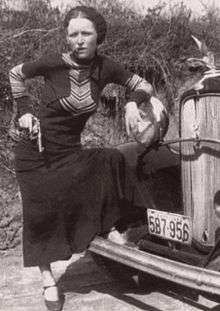
After Barrow was released from prison in February 1932, he and Ralph Fults assembled a rotating core group of associates. They began a series of small robberies, primarily of stores and gas stations; their goal was to collect enough money and firepower to launch a raid of liberation against Eastham prison.[26] On April 19, Bonnie Parker and Fults were captured in a failed hardware store burglary, where they intended to steal firearms, in Kaufman, Texas, and subsequently convicted and jailed.[29] While Parker was released in a few months after the grand jury failed to indict her, Fults was prosecuted and tried; he served time and never rejoined the gang.
On April 30, Barrow was the driver in a robbery in Hillsboro, Texas, during which the store's owner, J.N. Bucher, was shot and killed.[30] When shown mugshots, the victim's wife identified Barrow as one of the shooters, although he had stayed outside in the car.[31] It was the first time in the crime spree that Barrow was accused of murder.
Parker was held in jail until June 17, where she wrote poetry to pass the time.[32] When the Kaufman County grand jury convened, it declined to indict her, and she was released.[33] Within a few weeks, she reunited with Barrow.
On August 5, while Parker was visiting her mother in Dallas, Barrow, Raymond Hamilton and Ross Dyer[34] were drinking alcohol at a country dance in Stringtown, Oklahoma, when Sheriff C.G. Maxwell and his deputy, Eugene C. Moore, approached them in the parking lot. Barrow and Hamilton opened fire, killing the deputy and gravely wounding the sheriff.[35][36] This was the first time Barrow and his gang killed a lawman; eventually, they reached a total of nine. On October 11, they allegedly killed Howard Hall at his store during a robbery in Sherman, Texas, though historians have considered this unlikely since 1997.[37]
W. D. Jones had been a friend of the Barrow family since childhood. Only 16 years old on Christmas Eve 1932, he persuaded Barrow to let him join the pair and leave Dallas with them that night.[38] The next day, Jones was initiated when he and Barrow killed Doyle Johnson, a young family man, while stealing his car in Temple, Texas.[39] Less than two weeks later, on January 6, 1933, Barrow killed Tarrant County Deputy Sheriff Malcolm Davis when he, Parker and Jones wandered into a police trap set for another criminal.[40] The total murdered by the gang since April was five.
1933: Buck joins the gang
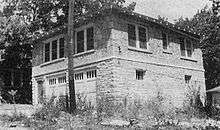
37°03′06″N 94°31′00″W / 37.051671°N 94.516693°W
On March 22, 1933, Buck Barrow was granted a full pardon and released from prison. Within days, he and his wife Blanche had set up housekeeping with Clyde, Parker and Jones in a temporary hideout at 3347 1/2 Oakridge Drive in Joplin, Missouri. According to family sources,[41] Buck and Blanche were there to visit; they tried to persuade Clyde to surrender to law enforcement.
Bonnie and Clyde's next brush with the law arose from their generally suspicious—and conspicuous—behavior, not because they had been identified. The group ran loud, alcohol-fueled card games late into the night in the quiet neighborhood. "We bought a case of beer a day", Blanche would later recall.[42] The men came and went noisily at all hours, and Clyde discharged a BAR (Browning Automatic Rifle) in the apartment while cleaning it.[43] No neighbors went to the house, but one reported suspicions to the Joplin Police Department.
The lawmen assembled a five-man force in two cars on April 13 to confront what they suspected were bootleggers living in the garage apartment. Though taken by surprise, Clyde was noted for remaining cool under fire. He, Jones, and Buck quickly killed Detective McGinnis and fatally wounded Constable Harryman.[44][45] During the escape from the apartment, Parker laid down covering fire with her BAR, forcing Highway Patrol Sergeant G. B. Kahler to duck behind a large oak tree while .30 caliber bullets struck the other side, forcing wood splinters into the sergeant's face.[46] Parker got into the car with the others. They slowed enough to pull in Blanche Barrow from the street, where she was pursuing her dog Snow Ball.[47] The surviving officers later testified that their side had fired only fourteen rounds in the conflict,[48] but one hit Jones on the side, one struck Clyde and was deflected by his suitcoat button, and one grazed Buck after ricocheting off a wall.

The group escaped the police at Joplin, but left behind most of their possessions at the apartment: items included Buck and Blanche's marriage license, Buck's parole papers (three weeks old), a large arsenal of weapons, a handwritten poem by Bonnie, and a camera with several rolls of undeveloped film.[52] The film was developed at The Joplin Globe and yielded many now-famous photos of Barrow, Parker and Jones clowning and pointing weapons at one another.[53] When the poem and the photos, including one of Parker clenching a cigar in her teeth and a pistol in her hand, went out on the newly installed newswire, the obscure five criminals from Dallas became front-page news across America as the Barrow Gang. The poem "Story of 'Suicide Sal'" was an apparent backstory.
For the next three months, the group ranged from Texas as far north as Minnesota. In May, they tried to rob the bank in Lucerne, Indiana[54] and robbed the bank in Okabena, Minnesota.[55] Previously they had kidnapped Dillard Darby and Sophia Stone at Ruston, Louisiana, in the course of stealing Darby's car; this was one of several incidents between 1932 and 1934 in which they kidnapped lawmen or robbery victims.[56] They usually released their hostages far from home, sometimes with money to help them return home.[5][57]
Stories of such encounters made headlines, as did the more violent episodes. The Barrow Gang did not hesitate to shoot anyone, lawman or civilian, who got in their way. Other members of the Barrow Gang known or thought to have committed murders included Raymond Hamilton, W.D. Jones, Buck Barrow and Henry Methvin. Eventually, the cold-bloodedness of their killings soured the public perception of the outlaws, and led to their ends.[58]
The photos entertained the public, but the gang was desperate and discontented, as described by Blanche Barrow in her account written while imprisoned in the late 1930s.[59] With their new notoriety, their daily lives became more difficult, as they tried to evade discovery. Restaurants and motels became less secure; they resorted to campfire cooking and bathing in cold streams.[60] The unrelieved, round-the-clock proximity among two couples, plus a fifth-wheel, in one car gave rise to vicious bickering.[61][62] So unpleasant did it become that W.D. Jones, who was the driver when he and Barrow stole Dillard Darby's car in late April, used that car to leave the others. He stayed away throughout May and up until June 8.[63]
On June 10, while driving with Jones and Parker near Wellington, Texas, Barrow missed warning signs at a bridge under construction and flipped their car into a ravine.[5][64] Sources disagree on whether there was a gasoline fire[65] or if Parker was doused with acid from the car's battery under the floorboards.[66] Parker sustained third-degree burns to her right leg so severe the muscles contracted and caused the leg to "draw up".[67]
Near the end of her life, Parker could hardly walk; she either hopped on her good leg or was carried by Clyde. After getting help from a nearby farm family and kidnapping two local lawmen,[68] the three outlaws rendezvoused with Blanche and Buck Barrow. They hid in a tourist court near Fort Smith, Arkansas, nursing Parker's burns. Buck and Jones bungled a local robbery and killed Town Marshal Henry D. Humphrey in Alma, Arkansas.[69] With the renewed pursuit by the law, they had to flee despite Parker's grave condition.[70]
July 1933: Platte City and Dexfield Park
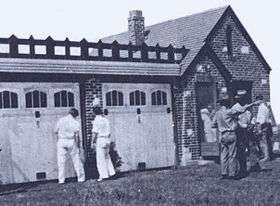
In July 1933, the gang checked into the Red Crown Tourist Court[71] south of Platte City, Missouri (now within the city limits of Kansas City, Missouri). It consisted of two brick cabins joined by garages, and the gang rented both.[71] To the south stood the Red Crown Tavern, a popular restaurant among Missouri Highway Patrolmen. The gang seemed to go out of their way to draw attention:[72] Blanche Barrow registered the party as three guests, but owner Neal Houser could see five people getting out of the car. He noted the driver backed into the garage "gangster style", for a quick getaway.[73] Blanche paid for their cabins with coins rather than bills, and repeated that later when buying five dinners and five beers.[74] The next day, Houser noticed that his guests had taped newspapers over the windows of their cabin; Blanche again paid for five meals with coins. Blanche's outfit— jodhpur riding breeches[75]—attracted attention; they were not typical attire for women in the area, and eyewitnesses reminiscing 40 years later mentioned them first.[73] Houser told Captain William Baxter of the Highway Patrol, a patron of his restaurant, about the group.[71]
Clyde and Jones went into town[76] to purchase bandages, crackers, cheese, and atropine sulfate to treat Bonnie's leg.[77] The druggist contacted Sheriff Holt Coffey, who put the cabins under surveillance. Coffey had been alerted by Oklahoma, Texas, and Arkansas law enforcement to watch for strangers seeking such supplies. The sheriff contacted Captain Baxter, who called for reinforcements from Kansas City, including an armored car.[71] At 11 p.m. that night, Sheriff Coffey led a group of officers armed with Thompson submachine guns toward the cabins.[78]
But in the pitched gunfight at considerable distances, the submachine guns proved no match for Clyde Barrow's preferred Browning Automatic Rifles (BAR), stolen July 7 from the National Guard armory at Enid, Oklahoma.[79] The Barrows laid down withering fire and escaped when a bullet short-circuited the horn on the armored car[80] and the lawmen mistook it for a cease-fire signal. They did not pursue the retreating Barrow vehicle.[71]
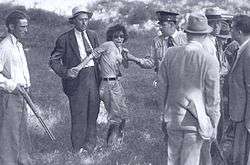
41°33′52″N 94°13′44″W / 41.564388°N 94.228942°W
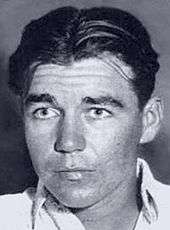
Although the gang had evaded the law again, Buck Barrow had sustained a gruesome and ultimately mortal bullet wound to his head that blasted a large hole in his forehead skull bone and exposed his injured brain, and Blanche was nearly blinded by glass fragments in both her eyes.[71][81] Their prospects for evading a manhunt dwindled.
Five days later, on July 24, the Barrow Gang was camped at Dexfield Park, an abandoned amusement park near Dexter, Iowa.[5][82] Although he was sometimes semiconscious, and even talked and ate, Buck's massive head wound and loss of blood was so severe that Clyde and Jones dug a grave for him.[83] After their bloody bandages were noticed by local residents, officers determined the campers were the Barrow gang. Local lawmen and approximately one hundred spectators surrounded the group, and the Barrows soon came under fire.[82] Clyde Barrow, Parker, and W.D. Jones escaped on foot.[5][82] Buck was shot in the back, and he and his wife were captured by the officers. Buck died five days later at Kings Daughters Hospital in Perry, Iowa, of his head wound and pneumonia after surgery.[82]
For the next six weeks, the remaining trio ranged far afield from their usual area of operations—west to Colorado, north to Minnesota, southeast to Mississippi—keeping a low profile and pulling only small robberies for subsistence.[84] They restocked their arsenal when Barrow and Jones burgled an armory at Plattville, Illinois on August 20, acquiring three BARs, handguns, and a large quantity of ammunition.[85]
By early September, they risked a run to Dallas to see their families for the first time in four months. Jones parted company with them, continuing to Houston, where his mother had moved.[5][82][86] He was arrested there without incident on November 16 and returned to Dallas. Through the autumn, Clyde Barrow executed a series of small-time robberies with a series of small-time local accomplices while his family and Parker's attended to her considerable medical needs.
On November 22, 1933, they narrowly evaded arrest while trying to hook up with family members near Sowers, Texas. Their hometown sheriff, Dallas' Smoot Schmid, and his squad, Deputies Bob Alcorn and Ted Hinton, lay in wait nearby. As Barrow drove up, he sensed a trap and drove past his family's car, at which point Schmid and his deputies stood up and opened fire with machine guns and a BAR. The family members in the crossfire were not hit, but a BAR bullet passed through the car, striking the legs of both Barrow and Parker.[87] They escaped that night.
The following week on November 28, a Dallas grand jury delivered a murder indictment against Parker and Barrow for the January 1933 killing of Tarrant County Deputy Malcolm Davis;[88] it was Parker's first warrant for murder.
1934: Final run
On January 16, 1934, Barrow orchestrated the escape of Raymond Hamilton, Henry Methvin and several others in the infamous "Eastham Breakout" of 1934.[26] The brazen raid generated negative publicity for Texas, and Barrow seemed to have achieved what historian Phillips described as his overriding goal: revenge on the Texas Department of Corrections.[89]
During the jailbreak, escapee Joe Palmer shot prison officer Major Joe Crowson.[90] This attack attracted the full power of the Texas and federal government to the manhunt for Barrow and Parker. As Crowson struggled for life, prison chief Lee Simmons reportedly promised him that all persons involved in the breakout would be hunted down and killed.[26] All were, except for Henry Methvin, whose life was traded for turning Barrow and Parker over to authorities.[26]
The Texas Department of Corrections contacted former Texas Ranger Captain Frank A. Hamer, and persuaded him to hunt down the Barrow Gang. Though retired, Hamer had retained his commission, which had not yet expired.[91] He accepted the assignment as a Texas Highway Patrol officer, secondarily assigned to the prison system as a special investigator, and given the specific task of taking Bonnie, Clyde and the Barrow Gang.
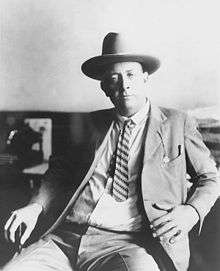
Tall, burly, taciturn, Hamer was described as unimpressed by authority and driven by an "inflexible adherence to right, or what he thinks is right."[92] For 20 years he had been feared and admired throughout Texas as "the walking embodiment of the 'One Riot, One Ranger' ethos."[93] He "had acquired a formidable reputation as a result of several spectacular captures and the shooting of a number of Texas criminals."[94] He was officially credited with 53 kills (and suffered 17 wounds).[95] Although prison boss Simmons always said publicly that Hamer had been his first choice, there is evidence he approached two other Rangers first, both of whom were reluctant to shoot a woman and declined.[96] Starting February 10, Hamer became the constant shadow of Barrow and Parker, living out of his car, just a town or two behind the bandits. Three of Hamer's brothers were also Texas Rangers, and while brother Harrison was the best shot of the four, Frank was considered the most tenacious.[97]
On April 1, 1934, Easter Sunday, Barrow and Henry Methvin killed two young highway patrolmen, H. D. Murphy and Edward Bryant Wheeler, at the intersection of Route 114 and Dove Road near Grapevine, Texas (now Southlake).[98][99] An eyewitness account stated that Barrow and Parker fired the fatal shots, and this story got widespread coverage[100] before it was discredited. Methvin later admitted he fired the first shot, after assuming Barrow wanted the officers killed; he also said that Parker approached the dying officers intending to help them, not to administer the coup de grâce described by the discredited eyewitness. Barrow joined in, firing at Patrolman Murphy. Most likely, Parker was asleep in the back seat when Methvin started shooting and took no part in the assault.[57]

In the spring of 1934, the Grapevine killings were recounted in exaggerated detail, affecting public perception: all four Dallas daily papers seized on the story told by the eyewitness, a farmer, who claimed to have seen Parker laugh at the way Patrolman Murphy's head "bounced like a rubber ball" on the ground as she shot him.[101] The stories claimed that police found a cigar butt "with tiny teeth marks" supposedly Parker's.[102] Several days later Murphy's fiancee wore her intended wedding dress to his funeral,[103] sparking photos and newspaper coverage. The eyewitness's ever-changing story was soon discredited, but the massive negative publicity, against Parker in particular, increased the public clamor for extermination of the survivors of the Barrow Gang.
The outcry also galvanized the authorities into action: Highway Patrol boss L.G. Phares immediately offered a $1,000 reward for "the dead bodies of the Grapevine slayers"—not their capture, just the bodies.[104] Texas governor Ma Ferguson added another $500 reward for each of the two alleged killers, which "meant for the first time there was a specific price on Bonnie's head, since she was so widely believed to have shot H.D. Murphy."[105]
Public hostility increased five days later, when Barrow and Methvin killed 60-year-old Constable William "Cal" Campbell, a widower single father, near Commerce, Oklahoma.[106] They kidnapped Commerce police chief Percy Boyd, drove around with him, crossing the state line into Kansas, and let him go, giving him a clean shirt, a few dollars, and a request from Parker to tell the world she did not smoke cigars. Boyd identified both Barrow and Parker to authorities but he never learned Methvin's name. The resultant arrest warrant for the Campbell murder specified "Clyde Barrow, Bonnie Parker and John Doe."[107] Historian Knight writes: "For the first time, Bonnie was seen as a killer, actually pulling the trigger—just like Clyde. Whatever chance she had for clemency had just been reduced."[104]
The Dallas Journal ran a cartoon on its editorial page showing the Texas electric chair, empty, but with a sign on it saying '"Reserved" and "Clyde and Bonnie".[108]
Deaths

Barrow and Parker were ambushed and killed on May 23, 1934, on a rural road in Bienville Parish, Louisiana.[82][109] The couple appeared in daylight in an automobile and were shot by a posse of four Texas officers (Frank Hamer, B.M. "Manny" Gault, Bob Alcorn, and Ted Hinton) and two Louisiana officers (Henderson Jordan and Prentiss Morel Oakley).[110]
The posse was led by Hamer who had begun tracking the pair on February 12, 1934. He studied the gang's movements and found they swung in a circle skirting the edges of five midwestern states, exploiting the "state line" rule that prevented officers from one jurisdiction from pursuing a fugitive into another. Barrow was a master of that pre-FBI rule, but consistent in his movements, so the experienced Hamer charted his path and predicted where he would go. The gang's itinerary centered on family visits, and they were due to see Methvin's family in Louisiana.
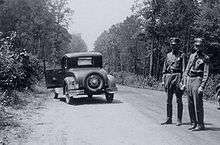
32°26′28.21″N 93°5′33.23″W / 32.4411694°N 93.0925639°W
On May 21, 1934, the four posse members from Texas were in Shreveport when they learned that Barrow and Parker were to go to Bienville Parish that evening with Methvin. Barrow had designated the residence of Methvin's parents as a rendezvous in case they were separated, and Methvin did get separated from the pair in Shreveport. The full posse, consisting of Captain Hamer, Dallas County Sheriff's Deputies Alcorn and Ted Hinton (both of whom knew Barrow and Parker by sight), former Texas Ranger B.M. "Manny" Gault, Bienville Parish Sheriff Henderson Jordan and his deputy Prentiss Oakley, set up an ambush at the rendezvous point along Louisiana State Highway 154 south of Gibsland toward Sailes. Hinton recounted that their group was in place by 9:00 pm on the 21st and waited through the whole next day (May 22) with no sign of the outlaw couple.[111] Other accounts said the officers set up on the evening of the 22nd.[112]

At approximately 9:15 a.m. on May 23, the posse, concealed in the bushes and almost ready to concede defeat, heard Barrow's stolen Ford V8 approaching at a high speed. The posse's official report had Barrow stopping to speak with Methvin's father, who had been planted there with his truck that morning to distract Barrow and force him into the lane closer to the posse. The lawmen opened fire, killing Barrow and Parker while shooting a combined total of about 130 rounds. Oakley fired first, probably before any order to do so.[111][113][114] Barrow was killed instantly by Oakley's initial head shot, but Hinton reported hearing Parker scream as she realized Barrow was dead, before the shooting at her fully began.[111] The officers emptied all their arms at the car.[115] Any one of the many wounds suffered by Bonnie and Clyde would have been fatal.[116]
According to statements made by Ted Hinton and Bob Alcorn:
"Each of us six officers had a shotgun and an automatic rifle and pistols. We opened fire with the automatic rifles. They were emptied before the car got even with us. Then we used shotguns ... There was smoke coming from the car, and it looked like it was on fire. After shooting the shotguns, we emptied the pistols at the car, which had passed us and ran into a ditch about 50 yards on down the road. It almost turned over. We kept shooting at the car even after it stopped. We weren't taking any chances."[109]
Researchers have said Bonnie and Clyde were shot more than fifty times each;[26] others claim closer to twenty-five wounds per corpse, or fifty total.[117] Officially, parish coroner Dr. J. L. Wade's 1934 report listed 17 separate entrance wounds on Barrow's body and 26 on Parker's,[118] including several headshots on each, and one that had snapped Barrow's spinal column. Undertaker C. F. "Boots" Bailey had difficulty embalming the bodies because of all the bullet holes.[119]
The temporarily deafened officers inspected the vehicle and discovered an arsenal of weapons, including stolen automatic rifles, sawed-off semi-automatic shotguns, assorted handguns, and several thousand rounds of ammunition, along with 15 sets of license plates from various states.[115]
Word of the ambush quickly got around when Hamer, Jordan, Oakley, and Hinton drove into town to telephone their respective bosses. A crowd soon gathered at the ambush spot. Gault and Alcorn, left to guard the bodies, lost control of the jostling, curious throng; one woman cut off bloody locks of Parker's hair and pieces from her dress, which were subsequently sold as souvenirs. Hinton returned to find a man trying to cut off Barrow's trigger finger, and was sickened by what was occurring.[111] Arriving at the scene, the coroner said he saw the following:
"... nearly everyone had begun collecting souvenirs such as shell casings, slivers of glass from the shattered car windows, and bloody pieces of clothing from the garments of Bonnie and Clyde. One eager man had opened his pocket knife, and was reaching into the car to cut off Clyde's left ear."[120]
The coroner enlisted Hamer for help in controlling the "circus-like atmosphere", and got people away from the car.[120]
The Ford, with the bodies, was towed to the Conger Furniture Store & funeral parlor in downtown Arcadia. Preliminary embalming was done by Bailey in a small preparation room in back of the furniture store (it was common for furniture and undertakers to be together).[121] The northwest Louisiana town was estimated to swell in population from 2,000 to 12,000 within hours, with the curious throngs arriving by train, horseback, buggy, and plane. Beer, which normally sold for 15 cents a bottle, jumped to 25 cents; ham sandwiches quickly sold out.[122] After identifying his son's body, Henry Barrow sat in a rocking chair in the furniture section and wept.[121]
H.D. Darby, a young undertaker who worked for the McClure Funeral Parlor in nearby Ruston, and Sophia Stone, a home demonstration agent also from Ruston, came to Arcadia to identify the bodies.[121] They had been kidnapped by the Barrow gang the previous year[123] in Ruston, on April 27, 1933, and released near Waldo, Arkansas. Parker reportedly had laughed when she asked Darby his profession and discovered he was an undertaker. She remarked that maybe someday he would be working on her.[121] Darby assisted Bailey in embalming the outlaws.[121]
Funeral and burial
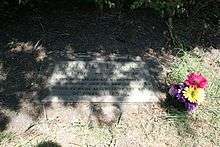
32°52′03″N 96°51′50″W / 32.8674164°N 96.8639145°W
Bonnie and Clyde wished to be buried side by side, but the Parker family would not allow it. Mrs. Parker wanted to grant her daughter's final wish, to be brought home, but the mobs surrounding the Parker house made that impossible.[124] More than 20,000 attended Bonnie Parker's funeral, and her family had difficulty reaching her gravesite.[124]
Parker's family used the now defunct McKamy-Campbell Funeral Home,[125] then located on Forest Avenue (now Martin Luther King, Jr. Boulevard) in Dallas, to conduct her funeral. Hubert "Buster" Parker accompanied his sister's body to Dallas from Arcadia in the McKamy-Campbell ambulance. Her services were held on Saturday, May 26, 1934, at 2 pm, in the funeral home, directed by Allen D. Campbell.[121] His son, Dr. Allen Campbell, later recalled that flowers came from everywhere, including some with cards allegedly from Pretty Boy Floyd and John Dillinger.[121] The largest floral tribute was sent by a group of Dallas city newsboys; the sudden end of Bonnie and Clyde sold 500,000 newspapers in Dallas alone.[126] Although initially buried in the Fishtrap Cemetery, Parker was moved in 1945 to the new Crown Hill Cemetery in Dallas.[121]
Barrow's family used the Sparkman-Holtz-Brand Morticians,[125] located in downtown Dallas. Thousands of people gathered outside both Dallas funeral homes hoping for a chance to view the bodies. Barrow's private funeral was held at sunset on Friday, May 25, in the funeral home chapel.[121] He was buried in Western Heights Cemetery in Dallas, next to his brother, Marvin. The Barrow brothers share a single granite marker with their names on it and a four-word epitaph previously selected by Clyde: "Gone but not forgotten."[127]
The life insurance policies for both Bonnie Parker and Clyde Barrow were paid in full by American National of Galveston. Since then, the policy of payouts has changed to exclude payouts in cases of deaths caused by any criminal act by the insured.[128]
The six men of the posse were each to receive a one-sixth share of the reward money. Dallas Sheriff Schmid had promised Ted Hinton this would total some $26,000,[129] but most of the state, county, and other organizations that had pledged reward funds reneged on their pledges. In the end, each lawman earned $200.23 for his efforts. They collected memorabilia.[130]
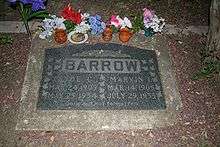
32°45′56″N 96°50′45″W / 32.7655373°N 96.8458633°W
The ambush of Barrow and Parker proved to be the beginning of the end of the "public enemy era" of the 1930s. By the summer of 1934, new federal statutes made bank robbery and kidnapping federal offenses; and the growing coordination of local jurisdictions by the FBI, plus two-way radios in police cars, combined to make the outlaw bandit sprees much more difficult to carry out than just months before. Two months after Gibsland, Dillinger was ambushed and killed on the street in Chicago; three months after that, Charles Arthur "Pretty Boy Floyd" was killed by 14 FBI bullets in the back in Ohio; and one month after that, Lester "Baby Face Nelson" Gillis shot it out, and lost, in Illinois.[131]
Controversies
Following the ambush, numerous questions arose, based on the differing accounts: Hamer and Gault were both former Texas Rangers then working for the Texas Department of Corrections, Hinton and Alcorn were employees of the Dallas Sheriff's office, and Jordan and Oakley were Sheriff and Deputy of Bienville Parish. The three duos distrusted each other, kept to themselves, and did not much like each other.[132] They each carried differing agendas into the operation and brought differing narratives out of it. Historian Guinn puts it this way:
- "[Hamer's, Simmons's, Jordan's and Hinton's] various testimonies combine into one of the most dazzling displays of deliberate obfuscation in modern history. Such widely varied accounts can't be dismissed as different people honestly recalling the same events different ways. Motive becomes an issue, and they all had reason to lie. Hamer was fanatical about protecting sources. Simmons was interested in resurrecting his own public image ... Jordan wanted to present himself as the critical dealmaker. Nobody can account for Ted Hinton's improbable reminiscences ..."[133]
Because their self-serving accounts vary so widely, and because all six men are long deceased, the exact details of the ambush are unknown and unknowable.[134] Lingering questions include whether fair warning was given the fugitives before the firing began, whether Parker should have been classified as a "shoot-on-sight" candidate, and the 1970s-era accusations of Deputy Hinton.
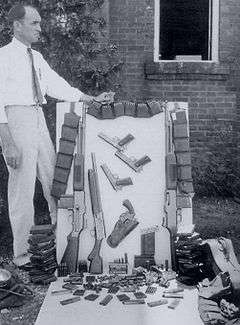
Calling a "Halt!"
Dallas Sheriff Schmid had previously warned Clyde Barrow before an ambush at Sowers, Texas in November 1933. When he called "Halt!", gunfire erupted from the outlaw car, it made a quick U-turn, and he saw rapidly vanishing taillights.[135] Hinton later said it was "the most futile gesture of the week."[136] When the two Louisiana posse officers discussed calling "Halt!", the four Texans "vetoed the idea,"[137] telling them[113] that Clyde's history had always been to shoot his way out, as had occurred in Platte City, Dexfield Park, and Sowers.[138] It is unlikely that Hamer planned to give warning, but Oakley stood up and opened fire; after a beat, the other officers joined him in firing.[113] Later, Jordan was reported as saying he called out to Barrow,[139] Alcorn said Hamer called out,[140] and Hinton claimed Alcorn did.[111] In another report, they each said they both did.[141] These conflicting claims were most likely collegial attempts to divert the focus from their gun-jumping associate Oakley, who later admitted firing too early.[142]
Warrants on Parker
Different sources have noted five occasions when Bonnie Parker may or may not have fired shots during crises faced by the gang.[143] The number of shots is unimportant as she never hit anyone, let alone murdered. But she was an accomplice to 100 or more felony criminal acts during her two-year career in crime, including eight murders,[144] seven kidnappings,[145] half-a-dozen bank robberies,[146] scores of felony armed robberies, countless automobile thefts, one major jailbreak[147] and an episode of assault and battery,[148] at a time when being a "habitual criminal" was a capital offense in Texas.[149] Because her gang kept on the run, Parker stayed a step ahead of legal entanglements.
After Joplin, she became identified among the wanted; the Joplin Police Department issued a Wanted for Murder poster[150] in April 1933 that featured her name and photo first, before Barrow's.[151] In June, another Wanted for Murder poster was distributed by Crawford County, Arkansas, with Parker's name and photo getting first billing. A $250 cash bounty was offered for either of the "Barrow Brothers" (Clyde and "Melvin"), with an alert to their need for medical care for a woman.[152]
By November 1933, W.D. Jones was in custody and supplying details of the gang's 1933 activities; a grand jury was empaneled in Dallas to hear material and decide on indictments. On November 28, the grand jury indicted Parker, Barrow, and Jones for the murder of Deputy Malcolm Davis in January; Judge Nolan G. Williams of Criminal District Court No. 2 issued arrest warrants for Parker and Barrow for murder.[88] Parker's assistance in the raid on Eastham prison in January 1934 earned her the enmity of a wide group of influential Texans. After being linked to the Grapevine murders, she was marked by a bounty set by the head of the Highway Patrol, and the Governor.[153] Five days later, Barrow and Henry Methvin killed Constable Campbell in Commerce, Oklahoma; the Oklahoma murder warrant named "Clyde Barrow, Bonnie Parker and John Doe" as his killers.[154]

Hinton's accusations
A travelling showman called Stanley toured with a lecture that supported some aspects of what Hinton later said. According to Stanley, Hamer had arranged the ambush through Methvin's family, which carried the implication that Hamer had secretly made an agreement that Methvin would escape justice. Methvin, who unlike WD Jones was not a juvenile, served a total of 8 years for being convicted of murdering Constable Campbell in Oklahoma. He was never tried for murdering two highway patrolmen near Grapevine, Texas, which Clyde accused him of in a letter to the Barrows. When Stanley came to Austin, Hamer slapped his face, took his slides and told him to stop putting on his show.[155] Stanley returned to Texas in 1939 for a performance at the State Fair, with Bob Alcorn and Ted Hinton as guards; Hamer did not show up.[156]
In 1979, Ted Hinton's as-told-to account of the ambush was published posthumously as Ambush. His version of the Methvin family's involvement in the planning and execution of the ambush was that the posse had tied Henry Methvin's father Ivy to a tree the previous night, to keep him from warning the outlaws off.[111] Hinton claimed that Hamer made a deal with Ivy Methvin: keep quiet about being tied up, and his son would escape prosecution for the Grapevine murders.[111] Hinton alleged that Hamer made every member of the posse swear they would never divulge this secret. Other accounts, however, place Methvin Senior at the center of the action, not tied up but on the road, waving for Clyde Barrow to stop[104][157] Hinton's memoir suggests that the stogie in the famous "cigar photo" of Bonnie had been a rose, and it was retouched as a cigar by darkroom staff at the Joplin Globe[158] while preparing the photo for publication.[159] Guinn says that "some people who knew [Hinton] suspect he became delusional late in life."[160]
Aftermath
The smoke from the fusillade had not cleared before the posse began sifting through the items in the Barrow death car. Hamer appropriated the "considerable" arsenal[161] of stolen guns and ammunition, plus a box of fishing tackle, under the terms of his compensation package with the Texas DOC.[162] In July, Clyde's mother Cumie wrote to Hamer asking for the return of the guns: "You don't never [sic] want to forget my boy was never tried in no court for murder, and no one is guilty until proven guilty by some court so I hope you will answer this letter and also return the guns I am asking for."[163] No record exists of any response.[163]
Alcorn claimed Barrow's saxophone from the car, but feeling guilty, later returned it to the Barrow family.[164] Other personal items such as Parker's clothing were also taken, and when the Parker family asked for them back, they were refused.[115][165] These items were later sold as souvenirs.[166] A rumored suitcase full of cash was said by the Barrow family to have been kept by Sheriff Jordan, "who soon after the ambush purchased an auction barn and land in Arcadia."[164] Jordan also attempted to keep the death car for his own but found himself the target of a lawsuit by Ruth Warren of Topeka, the owner of the car from whom Barrow had stolen the vehicle on April 29;[167] after considerable legal sparring and a court order, Jordan relented and the car was returned to Mrs. Warren in August 1934. It was still covered with blood and tissue. She had to pay an $85 towing and storage bill.[168]

In February 1935, Dallas and federal authorities conducted a "harboring trial" in which 20 family members and friends of the outlaw couple were arrested and jailed for the aid and abetment of Barrow and Parker. All twenty either pleaded or were found guilty. The two mothers were jailed for 30 days; other sentences ranged from two years' imprisonment for Raymond Hamilton's brother Floyd to one hour in custody for teenager Marie Barrow, Clyde's sister.[169] Other defendants included Blanche Barrow, W. D. Jones, Henry Methvin and Bonnie's sister Billie.
Blanche Barrow's injuries left her permanently blinded in her left eye. After the 1933 shootout at Dexfield Park, she was taken into custody on the charge of "Assault With Intent to Kill." She was sentenced to ten years in prison but was paroled in 1939 for good behavior. She returned to Dallas, leaving her life of crime in the past, and lived with her invalid father as his caregiver. She married Eddie Frasure in 1940, worked as a taxi cab dispatcher and a beautician, and completed the terms of her parole one year later. She lived in peace with her husband until he died of cancer in 1969. Warren Beatty approached her to purchase the rights to her name for use in the 1967 film Bonnie and Clyde. While she agreed to the original script, she objected to her characterization in the final film, describing Estelle Parsons's Academy Award-winning portrayal of her as "a screaming horse's ass." Despite this, she maintained a firm friendship with Beatty. She died from cancer at the age of 77 on December 24, 1988, and was buried in Dallas's Grove Hill Memorial Park under the name "Blanche B. Frasure".[170]
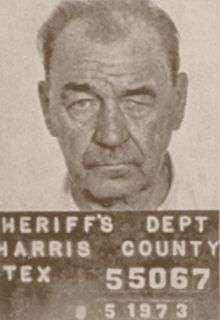
Barrow cohorts Raymond Hamilton and Joe Palmer, both Eastham escapees in January 1934, both recaptured, and both subsequently convicted of murder, had one more thing in common: They were both executed in the electric chair, "Old Sparky", at Huntsville, Texas, on the same day, May 10, 1935.[171] Barrow protégé W. D. Jones had split from his mentors six weeks after the three slipped the noose at Dexfield Park in July 1933.[172] He found his way to Houston and got a job picking cotton, where he was soon discovered and captured. He was returned to Dallas, where he dictated a "confession" in which he claimed to have been kept a prisoner by Barrow and Parker. Some of the more lurid embellishments he made concerned the gang's sex lives, and it was this testimony that gave rise to many of the stories about Barrow's ambiguous sexuality.[173] Jones was convicted of the murder of Doyle Johnson and served a lenient sentence of fifteen years. He struggled for years with substance-abuse problems, gave an interview to Playboy during the heyday of excitement surrounding the 1967 movie,[174] and was killed on August 4, 1974 in a misunderstanding by the jealous boyfriend of a woman he was trying to help out.[175]
Substitute protégé Henry Methvin's ambush-earned Texas pardon didn't help him in Oklahoma, where he was convicted of the 1934 murder of Constable Campbell at Commerce. He was paroled in 1942 and killed by a train in 1948; it was said that he fell asleep, drunk, on the tracks, but there were rumors that he had been pushed by parties seeking revenge for his betrayal of Clyde Barrow.[176] His father Ivy had been killed in 1946 by a hit-and-run driver,[177] and here too there was talk of foul play. Bonnie Parker's husband Roy Thornton was sentenced to five years in prison for burglary in March 1933. He was killed by guards on October 3, 1937, during an escape attempt from Eastham Farm prison.[15]
In the years after the ambush, Prentiss Oakley, who all six possemen agree fired the first shots,[111][178] was reported to have been troubled by his actions. He often admitted to his friends that he had fired prematurely[142] and he was the only posse member to express regret publicly. He would go on to succeed Henderson Jordan as sheriff of Bienville Parish in 1940.[142]
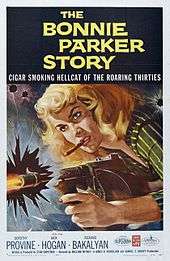
Frank Hamer returned to a quieter life as a freelance security consultant — a strikebreaker — for oil companies, although, according to Guinn, "his reputation suffered somewhat after Gibsland"[179] because many people felt he had not given Barrow and Parker a fair chance to surrender. He made headlines again in 1948 when he and Governor Coke Stevenson unsuccessfully challenged Lyndon Johnson's vote totals during the election for the U.S. Senate. He died in 1955 at age 71 after several years of poor health.[180] His possemate Bob Alcorn died on May 23, 1964, exactly thirty years to the day after the Gibsland ambush.[177]
The bullet-riddled Ford which Bonnie and Clyde had driven when they were killed became a popular traveling attraction that was initially displayed at fairs, amusement parks and flea markets for three decades, and became a fixture at a Nevada race track where it could be sat in for a dollar. The car eventually changed hands between casinos after settling momentarily in a Las Vegas car museum in the 1980s, moving between Iowa, Missouri and Nevada. The car is currently on display at Whiskey Pete's in Primm, Nevada.[181]
On April 1, 2011, the 77th anniversary of the Grapevine murders, Texas Rangers, troopers and DPS staff presented the Yellow Rose of Texas commendation to Ella Wheeler-McLeod, 95, the last surviving sibling of highway patrolman Edward Bryan Wheeler, killed that Easter Sunday by the Barrow Gang. They presented McLeod, of San Antonio, with a plaque and framed portrait of her brother.[182]
In media
Film
Hollywood has treated the story of Bonnie and Clyde several times, most notably:
- Dorothy Provine starred in the film The Bonnie Parker Story (1958), directed by William Witney.[183]
- Arthur Penn directed the best-known version of the tale, Bonnie and Clyde (1967), which starred Warren Beatty and Faye Dunaway.[183]
Music
- In December 1967 Serge Gainsbourg and Brigitte Bardot recorded the song "Bonnie and Clyde", which conveys a highly romanticized account of the pair, the lyrics borrowing heavily from Parker's "The Story of Bonnie and Clyde." The song, one of Gainsbourg's most famous and popular ones, was released in January 1968 on the LP Brigitte Bardot et Serge Gainsbourg, Bonnie and Clyde (Fontana 885529). The recording, with its hypnotic, repetitive string motif and eerie vocals and sound effects, has been sampled widely. The English-language version of the track is sung by Gainsbourg alone.
- In 1967 Georgie Fame released a single called "The Ballad of Bonnie and Clyde" (UK #1), whose lyrics tell of Bonnie's and Clyde's exploits.[184] This song was inspired by the movie about them.
- In 1968 Mel Torme wrote and performed the song "A Day in the Life of Bonnie and Clyde", featured on his album of the same name.
- In 1968 Merle Haggard recorded "The Legend of Bonnie and Clyde".
- In 1996 the German punk band Die Toten Hosen released the song "Bonnie & Clyde" on their seventh album Opium fürs Volk.
- In 2015 the American shoegaze band The Stargazer Lilies released the song "Bonnie and Clyde" as a single.
- In 2016 independent rock band The Cooch Experiment released the song "Bonnie and Clyde" on their debut album Starry Robe Sessions.
- In 2016 South-Korean artist Dean released his song "Bonnie and Clyde" from his first solo EP, 130 Mood: TRBL.
Musical theater
- On November 20, 2009, La Jolla Playhouse presented the world premiere of the musical Bonnie & Clyde. The production was adapted from the book by Ivan Menchell with music written by Frank Wildhorn and lyrics by Don Black. The cast was led by Laura Osnes as Bonnie and Stark Sands as Clyde.[185] The musical won the San Diego Theatre Critics Circle's Award for Outstanding New Musical and director Jeff Calhoun was honored for Best Direction of a Musical.
- The next production ran at the Asolo Repertory Theatre in Sarasota, Florida from November 12, 2010 through December 19, 2010, directed again by Jeff Calhoun. In this production Laura Osnes starred once more as Bonnie (for which she has received a nomination for a Tony Award for Best Actress in a Musical for the 2011–2012 year)[186] and Jeremy Jordan starred in the role of Clyde, Melissa van der Schyff as Blanche Barrow, and Claybourne Elder as Buck Barrow.[187] Bonnie & Clyde began previews on Broadway on November 4, 2011, with an official opening on December 1, 2011.[188] The show closed on December 30, 2011 after 69 performances.[189]
32°26′28.21″N 93°5′33.23″W / 32.4411694°N 93.0925639°W
Television
- In the TV film, Bonnie & Clyde: The True Story (1992), Tracey Needham played Bonnie while Clyde was portrayed by Dana Ashbrook.[190]
- Bruce Beresford directed a television miniseries, Bonnie & Clyde, which aired on Lifetime, History Channel, and A&E on December 8 and 9, 2013.[191]
- In March 2009 the pair were the subject a program in the BBC series Timewatch, based in part on gang members' private papers and previously unavailable police documents.[192]
- The Barrow gang's criminal career was featured in Season 28 of American Experience episode 'Bonnie & Clyde'.[193]
The Bonnie and Clyde Festival
Every year near the anniversary of the ambush, a "Bonnie and Clyde Festival" is hosted in the town of Gibsland, off Interstate 20 in Bienville Parish.[194] The ambush location, still comparatively isolated on Louisiana Highway 154, south of Gibsland, is commemorated by a stone marker that has been defaced to near illegibility by souvenir hunters and gunshot. A small metal version was added to accompany the stone monument. It was stolen, as was its replacement.
Historical perspective
Through the decades, many cultural historians have analyzed Bonnie's and Clyde's enduring appeal to the public imagination. E.R. Milner, an historian, writer, and expert on Bonnie and Clyde and their era, put the duo's enduring appeal to the public, both during the Depression and continuing on through the decades, into historical and cultural perspective. To those people who, as Milner says, "consider themselves outsiders, or oppose the existing system," Bonnie and Clyde represent the ultimate outsiders, revolting against an uncaring system.
"The country's money simply declined by 38 percent", explains Milner, author of The Lives and Times of Bonnie and Clyde. "Gaunt, dazed men roamed the city streets seeking jobs ... Breadlines and soup kitchens became jammed. (In rural areas) foreclosures forced more than 38 percent of farmers from their lands (while simultaneously) a catastrophic drought struck the Great Plains ... By the time Bonnie and Clyde became well known, many had felt that the capitalistic system had been abused by big business and government officials ... Now here were Bonnie and Clyde striking back."[120]
See also
- 1910 US Census with Clyde Barrow in Ellis County, Texas
- Hybristophilia, also known as "Bonnie and Clyde Syndrome"
- List of Depression-era outlaws
- Ride or die chick
- The Gouffé Case
Further reading
- John Boessenecker, Texas Ranger: The Epic Life of Frank Hamer, the Man Who Killed Bonnie and Clyde (2016)
References
Notes
- ↑ "FBI — Bonnie and Clyde". FBI.
- ↑ Toplin, Robert B. History by Hollywood: The Use and Abuse of the American Past (Urbana, IL: University of Illinois, 1996.) ISBN 0-252-06536-0.
- ↑ Phillips, John Neal (2002). Running with Bonnie & Clyde: The Ten Fast Years of Ralph Fults. Norman, OK: University of Oklahoma Press. ISBN 0-8061-3429-1.
- ↑ Jones deposition, November 18, 1933. FBI file 26-4114, Section Sub A, pp. 59–62. FBI Records and Information.
- 1 2 3 4 5 6 Jones, W.D. "Riding with Bonnie and Clyde", Playboy, November 1968. Reprinted at Cinetropic.com.
- ↑ Parker, Emma Krause; Nell Barrow Cowan and Jan I. Fortune (1968). The True Story of Bonnie and Clyde. New York: New American Library. ISBN 0-8488-2154-8. First published in September 1934 as Fugitives. Parker was Bonnie's mother, Cowan was Clyde's sister, and Fortune was a Dallas writer and reporter, who was chiefly responsible for the book. Parker and Cowan repudiated the book immediately upon its publication, but more for personal and family reasons than for factual inaccuracies. Page numbers in footnotes refer to the 1968 paperback edition.
- ↑ Guinn, Jeff (March 9, 2010). Go Down Together: The True, Untold Story of Bonnie and Clyde. Simon & Schuster. pp. 174–176. ISBN 9781471105753. Retrieved November 22, 2013.
- ↑ Phillips, p xxxv; Guinn, p 45
- ↑ Guinn, p 46
- ↑ "Bonnie and Clyde Genealogy Records". censusdiggins.com. Retrieved January 28, 2015.
- ↑ "The Story of Suicide Sal - Bonnie Parker 1932". cinetropic.com.
- ↑ "The Story of Bonnie and Clyde". cinetropic.com.
- ↑ Phillips, p xxxvi; Guinn, p 76
- ↑ A few months after their breakup Roy went to prison for robbery, and Bonnie told her mother, "Well, I didn't get [a divorce] before Roy was sent up, and it looks sort of dirty to file for one now." Parker, Cowan and Fortune, p. 56
- 1 2 "Bonnie & Roy." Bonnie and Clyde's Texas Hideout. Retrieved May 24, 2008.
- ↑ Guinn, p 79
- ↑ Parker, Cowan and Fortune, pp 55–57
- 1 2 3 4 5 6 "Bonnie and Clyde (Part 1)". American Experience. Season 24. Episode 4. PBS. January 19, 2016.
- ↑ "Clyde Barrow Death Certificate". "Bonnie and Clyde's Texas Hideout". Retrieved July 21, 2008.
- ↑ Barrow and Phillips, p. xxxv.
- ↑ Long, Christopher. "Barrow, Clyde Chesnut". Handbook of Texas Online. Texas State Historical Association. Retrieved December 1, 2012.
- ↑ Guinn provides a comprehensive description of West Dallas, p. 20.
- ↑ Guinn, p. 76.
- ↑ Phillips, Running, p 324n9
- ↑ Phillips, Running, p. 53.
- 1 2 3 4 5 6 Phillips, John Neal. "Bonnie & Clyde's Revenge on Eastham", Historynet.com, originally published in American History, October 2000.
- ↑ Parker, Cowan and Fortune, p 80
- ↑ Guinn, p. 81
- ↑ The items to be burgled were guns, not hardware. Guinn, pp 103–4
- ↑ Ramsey, Winston G., ed. (2003). On The Trail of Bonnie and Clyde: Then and Now. London: After The Battle Books. ISBN 1-870067-51-7, p 53. This book includes a comprehensive time line, and tells about half of its narrative through contemporary newspaper stories.
- ↑ Mrs. Bucher picked out photos of Barrow and Hamilton, but their two colleagues, Ted Rogers and Johnny Russell, were the ones who had entered the store that night. Barrow was in the driver's seat of the car, and Hamilton was not in Texas at the time but in Michigan (Guinn, p. 146). Rogers killed Bucher. Mrs. Bucher had seen Barrow with the pair of men that afternoon when they had been in the store. She likely mistook Rogers for Hamilton because of a strong resemblance between the two. So Barrow was accused of his first murder as a robber without being near it. Hamilton was later tried, convicted and sentenced to 99 years for this death, which was added to his growing sentence; it finally totaled 266 years. Rogers said he would come forward and confess if Hamilton got a death sentence, but did not when his buddy just got "time". Hamilton was executed in 1935 not for murder, but from being convicted as a "habitual criminal", then a capital offense in Texas. Barrow and Phillips, pp. 208–9.
- ↑ Guinn, p. 109. She composed these poems in an old bankbook the jailer's wife had given her to use as paper. Some were her own work, and some songs and poems she copied down from memory; Parker titled the lot "Poetry From Life's Other Side", and when she was released, either left it behind or gave it to the jailer. In 2007 the bankbook sold for $36,000. Item 5337 Bonhams 1793: Fine Art Auctioneers & Valuers Archived February 27, 2010, at the Wayback Machine. One of the poems was "The Story of Suicide Sal", a neatly penned, 105-line prisoner's lament told "in the jargon of gangdom." Parker, Cowan and Fortune, pp. 82–5; Guinn, p. 109. A year later, in an apartment the gang had rented in Joplin, Missouri, Parker was tinkering with "Sal" when a shootout began downstairs. This draft became the best known of Bonnie Parker's poems after "The Story of Bonnie and Clyde". Guinn, pp. 168, 172.
- ↑ Guinn, p. 115.
- ↑ Later that night, Dyer used his frequent alias of Everett Milligan with officers. Knight and Davis, p 54
- ↑ Guinn, p. 120
- ↑ "Deputy Sheriff Eugene C. Moore". The Officer Down Memorial Page. Retrieved November 5, 2009.
- ↑ Powell, Steven (2012). On 80th anniversary, Clyde Barrow no longer said to be Sherman murder.http://www.kxii.com/news/headlines/On-80th-anniversary-Clyde-Barrow-no-longer-said-to-be-Sherman-murder-173800241.html
- ↑ Guinn, p. 147
- ↑ Ramsey, pp 80–85
- ↑ "Deputy Malcolm Davis". The Officer Down Memorial Page. Retrieved November 5, 2009.
- ↑ Barrow and Phillips, pp 31–33. Blanche's book tells of the gang's two-week "vacation" in Joplin.
- ↑ Barrow and Phillips, p 45
- ↑ Barrow and Phillips, p.243 n30.
- ↑ "Detective Harry L. McGinnis". The Officer Down Memorial Page. Retrieved November 5, 2009.
- ↑ "Constable J.W. Harryman". The Officer Down Memorial Page. Retrieved November 5, 2009.
- ↑ Ballou, James L., Rock in a Hard Place: The Browning Automatic Rifle, Collector Grade Publications (2000), p. 78.
- ↑ Parker, Cowan and Fortune, p. 114.
- ↑ Ramsey, pp. 102. The contemporary photos and drawings of the hideout are particularly valuable.
- ↑ [ "It had a one-inch rubber band he'd cut out of a car-tire inner tube attached to the cutoff stock. He'd slip his arm through the band and when he put his coat on, you'd never know the gun was there. The rubber band would give when he snatched it up to fire." "Riding with Bonnie and Clyde."]
- ↑ [ Persell had watched their car slowly cruising the downtown area and suspected an imminent car theft. He stopped them on a bridge, which made Barrow suspect that more police were lying in wait on the other side. They released him unharmed six hours later and fifty miles away, but kept his Russian-made, custom-grip gun, which was next seen in the roll of photographs recovered at Joplin, in one picture hooked over the hood ornament of their latest stolen V-8, in another tucked into Barrow's waistband as Parker holds a shotgun on him and reaches to take it. "Riding with Bonnie and Clyde"; Guinn pp.157-59; O'Brien, Mike. "Book follows bloody trail of Bonnie, Clyde across Ozarks," Springfield News-Leader, January 4, 2004. The photographs: Ramsey pp. 108-13. Persell moved on with his life and never spoke much about the incident, though it came up again decades later, when he let his granddaughters bring him to school for show and tell. "Bank Robbers Bonnie, Clyde Kidnapped Policeman in 1933." Rootsweb: Local History. Originally published in the Springfield Leader-Press, Oct. 10, 1999.]
- ↑ [See preceding footnote]
- ↑ Parker, Cowan and Fortune, p 115
- ↑ Ramsey p 108–113. He said that he published all the frames from the Joplin rolls in proper sequence, but missed at least ten: one is a shot of W. D. Jones sitting at the wheel of the Rosborough car with "Bonnie's" cigar clenched in his teeth like FDR (Barrow and Phillips, p 60); another has Jones lounging atop the clay bank behind the car (Barrow and Phillips, p 107); another is a second shot of Clyde alone up on the rocks, but with his hat off (Knight and Davis, p 72). Three frames not yet published in books are available to view at the Bonnie and Clyde-oriented website Boodles Board : in two, W.D. is perched high on the rocks, and in a third, Clyde and W.D. play movie outlaws behind some large boulders, pointing their pistols. At the same website is a facsimile of a 1935 Startling Detective Adventures magazine, including a rare shot of Clyde squatting in front of the car by the clay bank. The final three of the missed ten are in the Ramsey book, but not included in the Joplin gallery: one is a "profile" of the Rosborough car alone (Ramsey, p 98); a second is Clyde standing by himself near the rocks with his hat in his hand (Ramsey, p 41); and finally a shot of Jones, with the weedy clay bank as background (Ramsey, p 80). The film was the then-popular size 116, discontinued in 1984; the Kodak No. 2A Folding Autographic Brownie camera, on loan from Blanche (Barrow and Phillips, p 227n10) produced eight shots per roll. The negatives known today are copy negs made in 1963. (Ramsey, p 107)
- ↑ Archived October 10, 2011, at the Wayback Machine.
- ↑ Ramsey, p 118 and p 122
- ↑ Clyde and Bonnie kidnapped seven persons during their crime career: Deputy Joe Johns on August 14, 1932; Officer Thomas Persell on January 26, 1933; civilians Dillard Darby and Sophia Stone on April 27, 1933; Sheriff George Corry and Chief Paul Hardy on June 10, 1933; and Chief Percy Boyd on April 6, 1934. All except Persell were taken across state lines. They also executed two "mini-kidnappings": on July 18, 1933, they kidnapped filling station attendants Harold Anderson and Harry Stark of Fort Dodge, Iowa, during the course of two sequential service station stick-ups. Upon stopping at a third station and robbing it, the gang realized they had no more room in the car for hostages, so they let Anderson and Stark go (Knight and Davis, p. 100).
- 1 2 Anderson, Brian. "Reality less romantic than outlaw legend". The Dallas Morning News. April 18, 2003.
- ↑ Guinn, pp 286–288
- ↑ Barrow and Phillips, pp 56. Blanche wrote that she felt, driving away from Joplin, that "all my hopes and dreams [were] tumbling down around me".
- ↑ Parker, Cowan and Fortune, pp 116–117
- ↑ Jones' Playboy interview, Barrow and Phillips, pp 65
- ↑ Barrow's sister Marie described her brother Buck as "the meanest, most hot-tempered" of all her siblings. Phillips, p 343n20
- ↑ Treherne, p 123; Blanche describes the cramped conditions in her book, pp 70–71.
- ↑ "Red River Plunge of Bonnie and Clyde - Marker Number: 4218". Texas Historic Sites Atlas. Texas Historical Commission. 1975.
- ↑ James R. Knight, "Incident at Alma: The Barrow Gang in Northwest Arkansas", The Arkansas Historical Quarterly, Vol. 56, No. 4 (Arkansas Historical Association Winter, 1997) 401. JSTOR 40027888.
- ↑ Guinn, pp 191–194. Six witnesses at a farmhouse described battery acid as the culprit; the open-fire story started with the Parker-Cowan-Fortune book; it was repeated in Jones' Playboy interview.
- ↑ Parker, Cowan and Fortune, p 132
- ↑ Clyde made a serious tactical error when he asked hostages Corry and Hardy if they had ever heard of the Barrow brothers, giving away their identity, and telling them that Parker was seriously wounded. After he released the officers, they told law enforcement world to be on the lookout for people buying burn medication and supplies. Guinn, p 194
- ↑ "Town Marshal Henry D. Humphrey". The Officer Down Memorial Page. Retrieved November 5, 2009.
- ↑ Ramsey, p. 150
- 1 2 3 4 5 6 Vasto, Mark. "Local lawmen shoot it out with notorious bandits". Platte County Landmark. Retrieved May 25, 2008.
- ↑ Knight, James R. and Jonathan Davis (2003). Bonnie and Clyde: A Twenty-First-Century Update. Waco, Texas: Eakin Press. ISBN 1-57168-794-7. p 100
- 1 2 Guinn, p 211
- ↑ Knight and Davis, p 112. The gang had many coins because they had broken into the gumball machines at the three service stations they robbed in Fort Dodge, Iowa, earlier that day. Guinn, pp 210–211
- ↑ Parker, Cowan and Fortune, p 117
- ↑ Sources are split on this: most say it was Blanche who went to town, but she recounted it as Clyde and Jones; p 112
- ↑ Barrow and Phillips, p 112
- ↑ "Red Crown Incident". TexasHideout. Retrieved May 25, 2008.
- ↑ Ramsey, p 153
- ↑ The armored car was an ordinary automobile that had been fortified with panels of extra boilerplate.
- ↑ Barrow and Phillips, pp 119–121
- 1 2 3 4 5 6 Vasto, Mark. "Further on up the road", Platte County Landmark. Retrieved May 25, 2008.
- ↑ Guinn, p 220
- ↑ Guinn, pp 234–235. Guinn writes that their clothes were so bloody after Dexfield that Bonnie, Clyde, and Jones wore sheets with slits cut for their heads, "like children out for Hallowe'en."
- ↑ Ramsey, p 186
- ↑ Knight and Davis had a different version, but once they split up, Jones never saw Barrow and Parker again. Knight and Davis, pp 114–115
- ↑ Knight and Davis, p. 118
- 1 2 "Clyde and Bonnie Names Reported in Slaying Bill", The Dallas Morning News, November 29, 1933, section II, p 1
- ↑ Phillips writes that Barrow had been so focused on this for so long, that after the Eastham raid, "life for Clyde Barrow became anticlimactic ... Only death remained, and he knew it." Phillips, Running, p. 217.
- ↑ "Major Joe Crowson". The Officer Down Memorial Page. Retrieved November 5, 2009. "Major" was Crowson's first name, not a military or TDOC rank.
- ↑ Frank Hamer and Bonnie & Clyde. Texas State Library and Archives Commission.
- ↑ Webb, p 531.
- ↑ Burrough, p 228.
- ↑ Treherne, p 172
- ↑ Guinn, p. 252
- ↑ Phillips, Running, p. 354n3
- ↑ Knight and Davis, p. 140
- ↑ "Patrolman H. D. Murphy". The Officer Down Memorial Page. Retrieved November 5, 2009.
- ↑ "Patrolman Edward Bryan Wheeler". The Officer Down Memorial Page. Retrieved November 5, 2009.
- ↑ Guinn, pp 284–286
- ↑ Guinn, p 284
- ↑ Ft. Worth Star-Telegram, April 2, 1934
- ↑ Guinn, p 285
- 1 2 3 Knight and Davis, p 147
- ↑ Guinn, p. 287
- ↑ "Constable William Calvin Campbell". The Officer Down Memorial Page. Retrieved November 5, 2009.
- ↑ Knight and Davis, p 217n12. Methvin's name was added to the warrant later in the summer, and he was eventually convicted and served time for the murder.
- ↑ "Cartoon online". The Dallas Journal. May 16, 1934.
- 1 2 "Took No Chances, Hinton and Alcorn Tell Newspapermen", Dallas Dispatch, 24 May 1934, Reprinted at Census Diggins. Accessed on 26 May 2008.
- ↑ "FBI — Bonnie and Clyde". FBI. Retrieved January 28, 2015.
- 1 2 3 4 5 6 7 8 Hinton, Ted and Larry Grove (1979). Ambush: The Real Story of Bonnie and Clyde. Austin, TX: Shoal Creek Publishers. ISBN 0-88319-041-9.
- ↑ Guinn, pp. 334.
- 1 2 3 Knight and Davis, p. 166.
- ↑ Guinn, pp. 339–40.
- 1 2 3 The Posse, Texas Hideout. Retrieved May 25, 2008.
- ↑ Knight and Davis, p. 167.
- ↑ Bonnie Parker and Clyde Barrow Artifacts. jeffreysward.com.
- ↑ Knight and Davis, p219n13
- ↑ Knight and Davis, p 171
- 1 2 3 Milner, E.R. The Lives and Times of Bonnie and Clyde. Southern Illinois University Press, 2003. ISBN 0-8093-2552-7. Published 1996.
- 1 2 3 4 5 6 7 8 9 Moshinskie, Dr. James F. "Funerals of the Famous: Bonnie & Clyde." The American Funeral Director, Vol. 130 (No. 10), October 2007, pp. 74–90.
- ↑ "Bonnie & Clyde's Demise", Dallas Journal at TexasHideout.
- ↑ Ramsey, p 112
- 1 2 Parker, Cowan and Fortune, p. 175.
- 1 2 "Skilled Embalmers." Dallas Journal at Texas Hideout.
- ↑ Phillips, Running, p. 219.
- ↑ Texas Country Reporter, May 25, 2013
- ↑ Parker, Cowan and Fortune, p 174
- ↑ Hinton, p 192
- ↑ Guinn, p 352
- ↑ Ramsey, pp 276–79
- ↑ Guinn, pp 335–336
- ↑ Guinn, pp 412–413n
- ↑ Guinn, p 425
- ↑ Schmid's Thompson submachine gun jammed on the first round and he could not get off one shot. Pursuit of Barrow was impossible because the posse had parked their own cars at a distance to prevent their being seen. Knight and Davis, p 118
- ↑ Guinn, p 240
- ↑ Phillips, Running, p 205
- ↑ Guinn, p 269
- ↑ By-lined Associated Press story by Jordan, New York Times and Dallas Morning News, May 24, 1934
- ↑ Dallas Morning News, May 24, 1934
- ↑ Dallas Dispatch, May 24, 1934.
- 1 2 3 Guinn, p. 357.
- ↑ The five episodes and their sources are: the Malcolm Davis murder, (W.D. Jones's 1933 deposition, p 1); the Joplin gunbattle, where Parker herself told her family she fired shots, (Parker, Cowan and Fortune, p 113); the Lucerne, Indiana bank robbery, (Barrow and Phillips, p 66); the Dexfield Park firefight, (Treherne, p 156); and the Sowers ambush, (Knight and Davis, p 118)
- ↑ Page numbers are from Ramsey: Doyle Johnson, pp 80; Malcolm Davis, pp 89; Harry McGinnis and Wes Harryman, pp 100; Major Crowson, pp 202; Edward B. Wheeler and H.D. Murphy, pp 218; Cal Campbell, pp 224
- ↑ Ramsey page numbers: Joe Johns, pp 66; Tom Persell, pp 92; Darby and Stone, pp 115; Corry and Hardy, pp 130; and Percy Boyd, pp 224
- ↑ Ramsey pages: Oronogo, Missouri, pp 78; Lucerne, Indiana, pp 118; Okabena, Minnesota, pp 122; Knierim, Iowa, pp 210; Stuart, Iowa, pp 232; Everly, Iowa, pp 236
- ↑ Ramsey, pp 202
- ↑ Bonnie punched kidnap hostage Sophia Stone on April 27, 1933: Barrow and Phillips, pp 247–248n8
- ↑ It was under this statute that Raymond Hamilton was executed in 1935. Barrow and Phillips, p 209
- ↑ "Obsolete Wanted Poster". Tulsa Tribune. 1969-09-06. Retrieved 2 June 2015.
- ↑ Knight and Davis, p 82. A subsequent poster from Joplin P.D. dropped Parker in favor of Buck, and offered cash bounties for each brother.
- ↑ Knight and Davis, p 98. The poster pictured and named Parker, Clyde, Buck and Blanche, plus unidentified suspect Jones, photo and description only. It was issued following the June 23 murder of Marshall Humphrey near Alma, a crime committed by Buck and Jones while Bonnie lay near comatose in Ft. Smith with Clyde and Blanche tending her.
- ↑ Knight and Davis, p 147, and Guinn, p 287
- ↑ Knight and Davis, p 217n12. Methvin's name was added to the warrant in the summer when his identity was confirmed
- ↑ Whole Shooting match, by Gary Cartwright Feb 2001, Texas monthly
- ↑ Go Down Together: The True, Untold Story of Bonnie and Clyde By Jeff Guinn
- ↑ Treherne, p 220
- ↑ Hinton, pp 39, 47
- ↑ But, the cigar is shown in other photos from the Joplin rolls shot at the same spot.Ramsey, pp. 108-109
- ↑ Guinn, p 413n
- ↑ Phillips, Running, p 207
- ↑ Hamer was interested in the Barrow hunt assignment, but the pay was only a third of what he made working for oil companies. To sweeten the deal, TDOC boss Lee Simmons granted Hamer title to all the stolen guns the posse would recover from the slain outlaws. Almost all the guns were the former property of the National Guard, pilfered from their armories during overnight burglaries. There was a thriving market for "celebrity" guns, even in 1934. Guinn, p 343. The verity of the provenance for guns purported to be Bonnie and Clyde's or used by Hammer in the ambush is not universally acknowledged.
- 1 2 Treherne, p 224
- 1 2 Guinn, p 343
- ↑ Emma Parker letter. TexasHideout. Retrieved May 26, 2008.
- ↑ Steele, p ; Phillips, pp 209–11.
- ↑ Ramsey, p. 234
- ↑ Knight and Davis, p 197. Amazingly, the engine still ran despite the battering the machine took in the ambush. After Jordan conceded ownership of the vehicle, Mrs. Warren arrived in Arcadia to claim it and then drove it, still in its gruesome state, to Shreveport, from which point she had it trucked back to Topeka. The legal bills in her tussle with Sheriff Jordan exceeded $3,000, a lot of money in 1934. Ramsey, p 272. In the 1970s, the car sold at auction for twice the price of Adolf Hitler's massive Mercedes open touring car, and after being displayed in various locations, was most recently on display in Terrible's Gold Ranch Casino in Verdi, Nevada; however, as of February 8, 2012 it is no longer there. Terrible's staff members stated the vehicle was removed and will not be back. No further details given.
- ↑ Guinn, pp 354–355
- ↑ Barrow and Phillips, p.249n
- ↑ Knight and Davis, p 188
- ↑ Ramsey, p 196
- ↑ Toland, John (1963). The Dillinger Days. New York: Random House. ISBN 0-306-80626-6 (1995 Da Capo ed.), p. 83
- ↑ "Riding with Bonnie and Clyde by W.D. Jones". Cinetropic.com. May 23, 1934. Retrieved June 12, 2012.
- ↑ Knight and Davis, p. 189. The man who killed W.D., George Arthur Jones (no relation), would ultimately commit suicide with the same shotgun
- ↑ Knight and Davis, p 190
- 1 2 Guinn, p 358
- ↑ Phillips, Running, p 206
- ↑ Guinn, p 356
- ↑ Knight and Davis, p 191
- ↑ Bonnie and Clyde's Death Car, Primm, Nevada, roadsideamerica.com. Retrieved December 3, 2014.
- ↑ Davis, Vincent T. "Texas honors officer killed by Bonnie and Clyde, sister given commendation 77 years later", Houston Chronicle, April 2, 2011
- 1 2 Walker, John, ed. (1994). Halliwell's Film Guide. New York: Harper Perennial. ISBN 0-06-273241-2. p. 150
- ↑ "Observer - The Guardian". the Guardian. Archived from the original on September 8, 2008. Retrieved January 28, 2015.
- ↑ McNulty, Charles (November 23, 2009). "Theater review: 'Bonnie & Clyde' at La Jolla Playhouse". Los Angeles Times. Retrieved February 28, 2010.
- ↑ "The American Theatre Wing's Tony Awards® – Official Website by IBM". TonyAwards.com. Retrieved June 12, 2012.
- ↑ "Broadway's Best Show – Bonnie & Clyde at Asolo Repertory". Broadway's Best Shows, Inc. Retrieved April 29, 2011.
- ↑ "Broadway's Best Show – Bonnie & Clyde Coming to Broadway Fall 2011. Previews Begin November 4, 2011". Broadway's Best Shows, Inc. Retrieved September 7, 2011.
- ↑ Heller, Scott (December 16, 2011). "Bonnie & Clyde Will Close on Dec. 30". The New York Times. Retrieved December 31, 2011.
- ↑ "Bonnie and Clyde: The True Story1992". reelzchannel.com. Retrieved November 18, 2010.
- ↑ "First look at A&E Network's 'Bonnie & Clyde' remake: Recast movies & TV roles". New York Daily News.
- ↑ "BBC Two - Timewatch, 2008-2009, The Real Bonnie and Clyde". BBC. Retrieved January 28, 2015.
- ↑ "Bonnie & Clyde . American Experience .". PBS. Retrieved January 14, 2016.
- ↑ "Bonnie and Clyde live on". The Washington Times. May 23, 2004. Retrieved June 17, 2005.
Bibliography
- Barrow, Blanche Caldwell and John Neal Phillips. My Life with Bonnie and Clyde. (Norman: University of Oklahoma Press, 2004.) ISBN 978-0-8061-3715-5.
- Burrough, Bryan. Public Enemies. (New York: The Penguin Press, 2004.) ISBN 1-59420-021-1.
- Guinn, Jeff. Go Down Together: The True, Untold Story of Bonnie and Clyde. (New York: Simon & Schuster, 2009.) ISBN 1-4165-5706-7.
- Knight, James R. and Jonathan Davis. Bonnie and Clyde: A Twenty-First-Century Update. (Austin, TX: Eakin Press, 2003.) ISBN 1-57168-794-7.
- Milner, E.R. The Lives and Times of Bonnie and Clyde (Carbondale and Edwardsville: Southern Illinois University Press, 1996.) ISBN 0-8093-2552-7.
- Parker, Emma Krause, Nell Barrow Cowan and Jan I. Fortune. The True Story of Bonnie and Clyde. (New York: New American Library, 1968.) ISBN 0-8488-2154-8. Originally published in 1934 as Fugitives.
- Phillips, John Neal. Running with Bonnie and Clyde, the Ten Fast Years of Ralph Fults. (Norman: University of Oklahoma Press, 1996, 2002) ISBN 0-8061-3429-1.
- Ramsey, Winston G., ed. On The Trail of Bonnie and Clyde. (London: After The Battle Books, 2003). ISBN 1-870067-51-7.
- Steele, Phillip, and Marie Barrow Scoma. The Family Story of Bonnie and Clyde. (Gretna, LA: Pelican Publishing Company, 2000.) ISBN 1-56554-756-X.
- Treherne, John. The Strange History of Bonnie and Clyde. (New York: Stein and Day, 1984.) ISBN 0-8154-1106-5.
- Webb, Walter Prescott. The Texas Rangers: A Century of Frontier Defense. (Austin: University of Texas Press, 1935.) ISBN 0-292-78110-5.
External links
| Wikimedia Commons has media related to Bonnie and Clyde. |
- FBI files on Bonnie and Clyde, covering 1933-1944
- The Poems of Bonnie Parker
- Unauthenticated Barrow letter to Henry Ford
- The Clyde Barrow Gang collection from the Dallas Police Department Archives
- "Bonnie Elizabeth Parker". Legendary Outlaw. Find a Grave. January 1, 2001. Retrieved August 18, 2011.
- "Clyde Barrow". Find a Grave. January 1, 2001. Retrieved August 18, 2011.
